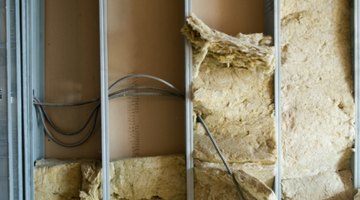How to Properly Install Paper-Backed Wall Insulation
Paper-backed wall insulation comes in rolls of batting. It is available in standard widths to fit between the studs inside your wall. Some batting is perforated so that you can tear it to fit into spaces that aren’t a standard size.

Things You Will Need
- Measuring tape
- Utility knife
- Straight board
- Scrap plywood
The paper backing on this batting is usually kraft paper and serves as a barrier that slows vapor from penetrating into the insulation. Paper-backed insulation is designed for exterior walls, ceilings and basements.
-
Measure the walls that you want to insulate, using a tape measure. It is better to have too much insulation than not enough. The walls should be unfinished on one side, meaning there is drywall or other sheeting on one side of the studs but not on the other. You will install the insulation from the unfinished side before finishing the wall.
-
Unroll the insulation and allow it to expand to its full length. Measure the wall again where the batt will go and cut the batt to that length, using a utility knife. Cut on the insulation side, not the paper side. Lay a straight board at the point where you will cut, put one knee on the board to compress the batt and cut along the board with the utility knife. Cut with a scrap piece of plywood underneath.
-
Pick up the batt and push it into the space between the wall studs. The paper backing should face the interior of the room or the side that faces the heated or air-conditioned space. The batt should stay flat between the studs by itself. If it falls, your batting is too narrow. If it bunches, it is too wide. Push in the top edge near the ceiling first and tuck it between the studs working your way toward the floor.
-
Adjust the corners and edges to fill the space and fit snugly and well. Pull on the paper backing so that the paper’s surface is even with the edges of the studs. This will let the insulation expand into the wall space.
-
Cut through the insulation down to the paper where wiring or pipes are and tuck insulation around them.
Tip
Paper-backed insulation comes in a variety of R values. The higher the R value the more insulation is provided. R-11 is used most often for interior walls and sound-deadening. R-13 to R21 is frequently installed in exterior walls. R-30 and R-38 is most used in ceilings and attics. Studs made of two-by-four boards need R11 or R13; 2 by 6 studs need R-19. Local building codes may dictate other ways to install paper-backed wall insulation, such as specifying that it be stapled. Check your local codes before installing the insulation. If you staple, use the paper flanges on the rolled batting. Staple it to the inside of the wall studs every 6 inches, working your way from top to bottom. If you piece together more than one batt in any given area, ensure the batts come together with no space between and no bunching.
Warning
Insulation, especially made from fiberglass, is an irritant and can damage your skin, lungs and eyes. Wear safety glasses, a mask, long trousers, a long-sleeved shirt and gloves for this job.
References
Tips
- Paper-backed insulation comes in a variety of R values. The higher the R value the more insulation is provided. R-11 is used most often for interior walls and sound-deadening. R-13 to R21 is frequently installed in exterior walls. R-30 and R-38 is most used in ceilings and attics. Studs made of two-by-four boards need R11 or R13; 2 by 6 studs need R-19.
- Local building codes may dictate other ways to install paper-backed wall insulation, such as specifying that it be stapled. Check your local codes before installing the insulation. If you staple, use the paper flanges on the rolled batting. Staple it to the inside of the wall studs every 6 inches, working your way from top to bottom.
- If you piece together more than one batt in any given area, ensure the batts come together with no space between and no bunching.
Warnings
- Insulation, especially made from fiberglass, is an irritant and can damage your skin, lungs and eyes. Wear safety glasses, a mask, long trousers, a long-sleeved shirt and gloves for this job.
Writer Bio
Karren Doll Tolliver holds a Bachelor of English from Mississippi University for Women and a CELTA teaching certificate from Akcent Language School in Prague. Also a photographer, she records adventures by camera, combining photos with journals in her blogs. Her latest book, "A Travel for Taste: Germany," was published in 2015.
Photo Credits
- Jupiterimages/Photos.com/Getty Images
- Jupiterimages/Photos.com/Getty Images
More Articles



